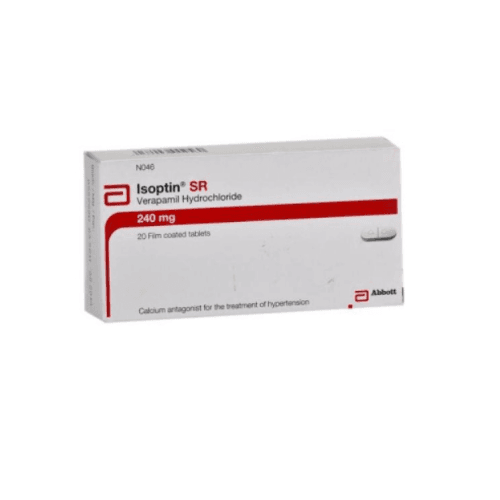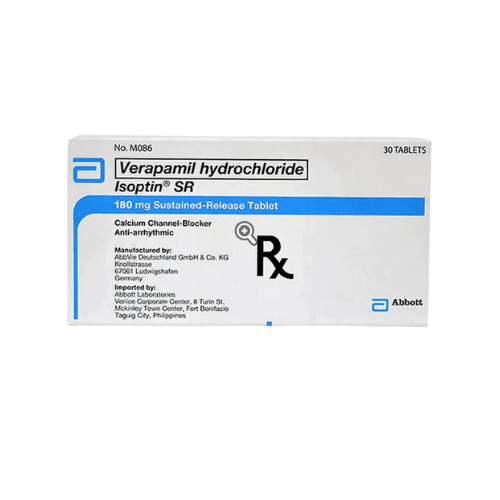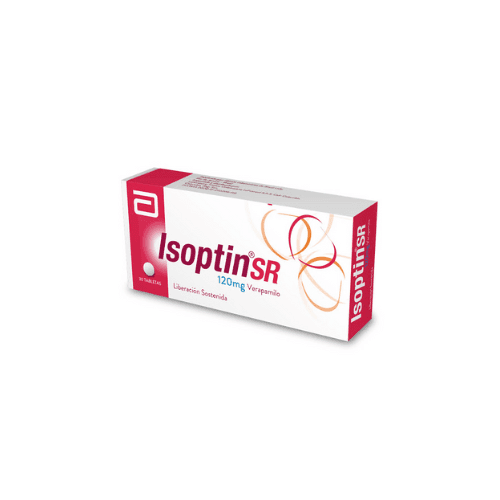{acf_product_warning_message}
This sustained-release verapamil tablet helps lower blood pressure and control certain heart rhythm problems. The guide below explains key uses, safety, and how to use it correctly.
You can compare options for Isoptin SR® 240 mg without insurance with US delivery from Canada.
What Isoptin SR Is and How It Works
YouDrugstore is a licensed Canadian pharmacy in Manitoba. Pharmacists review prescriptions before dispensing.
Isoptin SR® contains verapamil, a calcium channel blocker. It reduces calcium entry into heart muscle and blood vessel walls. This relaxes vessels, lowers blood pressure, and eases the heart’s workload. It also slows conduction through the AV node, which helps control certain fast heart rhythms.
The sustained-release design provides steadier levels throughout the day. That can support consistent blood pressure control and reduce angina episodes. Verapamil can also help manage rate control in atrial fibrillation when appropriate.
Some patients receive verapamil SR 240 mg tablets as part of a long-term plan. Your prescriber decides the regimen based on your diagnosis, response, and other medicines.
Who It’s For
This medicine is used for adults with high blood pressure, chronic stable angina, or certain supraventricular arrhythmias. It may be used to help control ventricular rate in atrial fibrillation or atrial flutter as directed by a clinician. It is not for rapid treatment of acute chest pain or emergencies.
People with severe left ventricular dysfunction, dangerously low blood pressure, advanced heart block, sick sinus syndrome without a pacemaker, or cardiogenic shock should not use this therapy. Those with Wolff-Parkinson-White syndrome and atrial fibrillation need special caution. Discuss use if you have liver impairment or heart failure. Tell your prescriber about all medicines and supplements you take.
Dosage and Usage
Follow your prescription exactly. Take sustained-release tablets at the same time each day. Swallow whole with water; do not crush, split, or chew. Taking with food can improve tolerability, but follow label directions if your specific product advises otherwise.
Your prescriber may start with a lower amount and adjust over time. Typical use is once daily for blood pressure. For angina or rhythm control, the plan may differ. Avoid grapefruit and grapefruit juice, which can raise verapamil levels. Alcohol can enhance blood-pressure–lowering effects and dizziness.
If your plan includes verapamil ER 240 mg tablets, keep a daily routine to support steady levels. Check blood pressure and heart rate as instructed. Do not change your dose or schedule without consulting your clinician.
Strengths and Forms
Isoptin SR 240 mg tablets are a common sustained-release presentation. Other formulations may include 120 mg and 180 mg sustained-release tablets. Immediate-release forms of verapamil also exist, but they are used differently and on different schedules. Availability can vary by market and supplier.
Missed Dose and Timing
If you miss a dose, take it when you remember unless it is close to the next scheduled time. If it is close, skip the missed dose and resume your usual routine. Do not double up. Consistent daily timing helps maintain steady effects and lowers the chance of side effects.
Storage and Travel Basics
Store tablets at room temperature, away from excess heat and moisture. Keep them in the original, child-resistant container with the label intact. Do not store in a bathroom or a hot car. For travel, carry your prescription and medicines in your hand luggage. Keep a simple list of your current medicines and prescriber contact details. Use a pill organizer only if it keeps tablets protected and labeled.
Benefits
As a calcium channel blocker, this treatment may lower blood pressure, reduce angina frequency, and improve exercise tolerance. A sustained-release dose can support smoother control with once-daily use in many patients. When used for rate control, it can help stabilize heart rate as guided by your prescriber. Many people appreciate predictable dosing and the option to combine with other antihypertensives when appropriate.
Side Effects and Safety
- Constipation, usually mild
- Dizziness or lightheadedness
- Headache
- Nausea or stomach discomfort
- Flushing
- Swelling in the ankles or feet
Serious effects are less common but can include slow heart rate, heart block, low blood pressure, worsening heart failure, or liver enzyme changes. Gum overgrowth may occur with prolonged use. Seek urgent care for chest pain that does not improve, fainting, shortness of breath, or swelling that rapidly worsens. This medicine can add to the heart-rate–lowering effects of beta blockers and other therapies; your care team monitors for this.
Drug Interactions and Cautions
Verapamil is affected by CYP3A4 inhibitors and inducers. Azole antifungals, macrolide antibiotics, protease inhibitors, and some calcium channel blockers can raise levels. Rifampin and certain anticonvulsants can lower levels. Verapamil can increase concentrations of digoxin and some statins, especially simvastatin. Dose limits often apply when combined with simvastatin. Avoid grapefruit. Alcohol can boost blood-pressure–lowering effects.
Tell your clinician if you use beta blockers, antiarrhythmics, lithium, or neuromuscular blockers. Use caution if you have liver disease, edema, conduction disturbances, or heart failure. Follow the official label and your prescriber’s guidance for any changes.
What to Expect Over Time
With regular dosing, blood pressure control may build progressively. For angina, fewer attacks and better exercise tolerance are common goals. For rhythm control, steadier resting rates may occur when used appropriately. It may take consistent daily use to gauge response. Keep a home blood pressure log and note any symptoms like fatigue or dizziness. Report concerns so your care team can adjust your plan.
Your clinician may specify verapamil 240 mg sustained release if it matches your needs. Do not stop suddenly unless advised, as symptoms can rebound. Keep follow-up appointments to review response, side effects, and any interaction risks.
Compare With Alternatives
Some people use generic Verapamil sustained-release tablets for similar indications. Others may be prescribed Diltiazem, another calcium channel blocker used for blood pressure, angina, or rate control. Your prescriber will help you choose based on your condition, response, and interaction profile.
Pricing and Access
We offer options aligned with Canadian pricing to help manage out-of-pocket costs. You can review current availability and see if manufacturer or pharmacy programs apply. Many patients compare branded and generic options to meet budget and clinical goals. For potential savings, check our Promotions page periodically.
For transparency on brand-specific terms, look for Isoptin SR 240 mg Canadian pricing details on the product page when in stock. Orders are processed through an encrypted checkout, and eligible prescriptions are filled for therapy that Ships from Canada to US.
Availability and Substitutions
Stock can vary. If your exact item is not available, your prescriber may recommend an equivalent sustained-release verapamil or a different class option. In some cases, pharmacies coordinate with your clinician to dispense a therapeutically appropriate alternative.
When listed, Isoptin SR 240 mg tablets from Canada may be supplied by different manufacturers depending on market availability. Packaging and pill markings can differ by source and strength. Always review the label in your package and contact us if anything looks unexpected.
Patient Suitability and Cost-Saving Tips
Good candidates often include adults with hypertension, chronic stable angina, or certain supraventricular arrhythmias who can take a calcium channel blocker safely. Those with advanced conduction disease, severe hypotension, or decompensated heart failure may not be suitable. People with significant liver disease require careful supervision.
To save on therapy, ask your prescriber whether a multi-month fill is appropriate. A 60- or 90-day supply can reduce per-fill fees and help maintain continuity. Set refill reminders so you do not miss doses. Consider a generic sustained-release verapamil if it fits your plan. Use one pharmacy to simplify interaction checks and counseling.
Questions to Ask Your Clinician
- Primary goal: blood pressure control, angina relief, or rate control?
- Expected schedule: once daily or a different plan?
- Any restrictions on food, alcohol, or grapefruit products?
- Which symptoms should trigger a call or urgent care?
- How will other heart medicines affect my regimen?
- What monitoring is needed for heart rate and blood pressure?
Authoritative Sources
FDA DailyMed: Verapamil ERHealth Canada Drug Product DatabaseFDA Prescribing Information Archive
Ready to proceed? Place your request with YouDrugstore for secure checkout and express US shipping from Canada, with temperature-controlled handling when required. This information is educational and does not replace your prescriber’s advice.
Express Shipping - from $25.00
Shipping with this method takes 3-5 days
Prices:
- Dry-Packed Products $25.00
- Cold-Packed Products $35.00
Shipping Countries:
- United States (all contiguous states**)
- Worldwide (excludes some countries***)
Standard Shipping - $15.00
Shipping with this method takes 5-10 days
Prices:
- Dry-Packed Products $15.00
- Not available for Cold-Packed products
Shipping Countries:
- United States (all contiguous states**)
- Worldwide (excludes some countries***)
Do I need a prescription to order medication from YouDrugstore?
If you wish to order prescription medication from YouDrugstore, yes you do need a valid prescription issued by your local doctor. You do not need a prescription to order over-the-counter health products marked as non-prescription or over-the-counter on our website.
How do I order prescription medication from YouDrugstore?
We make it easy to order prescriptions from YouDrugstore.com any time, 24 hours a day, 7 days a week. Simply search the website and select items to add to your shopping cart. When you check out, send us your original prescription for all prescription drugs. After receiving your order and prescription, our team of pharmacists, technicians, and physicians must review them before we can ship your package. We will not charge your credit card or process your payment until your prescription is approved.
For more information on how to order prescription medication from YouDrugstore, view our How To Order page.
How much does shipping cost when I order from YouDrugstore?
When your order is more than $100, shipping is completely free. For orders less than $100, you just pay a $15 flat-rate shipping fee for your entire order. YouDrugstore.com also sells a wide variety of over-the-counter health products if you want to order more to spend $100 and get free shipping. You can learn more by reading our Shipping and Returns Policy.
When will I receive my YouDrugstore order?
Most orders reach their destination within 7 to 10 days. However, please allow up to 21 days after we ship your order to allow it to reach your home address. Please note that we can only ship your order after we have received your payment and an original copy of your prescription.
Will the pills or packaging be different when I order from YouDrugstore?
If you usually take a brand name pill and have instead ordered a generic drug, your pills may look different. Although they may look different, generic versions of a drug have the same active ingredients and work in exactly the same way as the brand-name medication. The appearance of medication or packaging may also differ from country to country, even though the strength is the same. For example, Celexa 20MG is usually a peach-colored pill, but in Canada it is white and slightly smaller, even though the same company manufactures both pills. Two different brands of generic medication may also look different because they are made by different manufacturers, although they are equivalent in every other way.
How does medication from Canada differ from medication in other regions of the world?
Canada has high standards and regulations governing the manufacturing of medication and health products and the licensing of doctors and pharmacists. Despite some possible cosmetic differences, medication from Canada is the same quality and strength as medication from other areas like the United States.
Why are prices on YouDrugstore different from prices at other pharmacies?
Unlike some regions of the world, Canadian medication prices are regulated with limits on how much patients have to pay for their prescriptions. This means that Canadian drug costs are often lower than other regions.
Is it safe to place my order online?
YouDrugstore runs a daily McAfee security scan to check for any potential vulnerabilities on our website, which ensures our servers and software are always up to the highest standards of online safety. We also use 256bit encryption to transfer all sensitive information through our website, including your payment information and contact information, with an SSL certificate from GeoTrust.
Where can I find YouDrugstore's policies on returns, privacy, and security?
If you want to know more about YouDrugstore’s Privacy Policy, Return Policy, and Security Policy, you can read them at:


